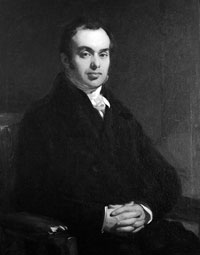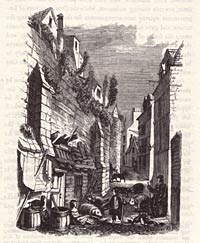
Dr Thomas Shapter - doctor and writer on cholera
Page updated 18th March 2010
Return to Exeter People Menu
Early Nineteenth Century Exeter was a miserable place for the poor and unemployed. The City Corporation were not much concerned about the poor and their conditions. Consequently, such public services as sewerage and clean water were not high priorities. It was into this Exeter that a young doctor moved who would do much for the poor.
Thomas Shapter was born in Gibraltar in 1809. He had graduated as a medical doctor from Edinburgh University, a contemporary of the eminent Charles Darwin. However, Shapter stuck with medicine, unlike Darwin. He arrived in Exeter during 1832, the year of the infamous cholera outbreak. Almost immediately he was draughted into the fight against the disease. The first victim of the cholera was a woman who had recently returned from Plymouth to North Street - she died on 19th July 1832. A few brave physicians including Dr Shapter and Dr Hennis tended the sick during the outbreak. They gained a reputation for helping the poor, especially in the West Quarter and Exe Island.
After the outbreak, Shapter developed his practice and by 1835 he had become a member of the governing body of the City, the Chamber. This was a considerable success for a young physician. In 1840, he married the Rev. Samuel Blackall's daughter. With his elevation in civic life, he moved to 1 Barnfield Crescent and gained a reputation as a collector of art, including early photographs. During this time, the various hospitals and workhouses were more or less independent - some were supported by the church, others by the Corporation and some were attached to charitable institutes. Shapter worked at the Magdalen Hospital, the Lying-in-Charity and St Thomas' Hospital for Lunatics, which eventually would be transferred to Wonford House. In 1847 he obtained a position at the Devon and Exeter Hospital, Southernhay.
It was in 1848 that he decided to write an account of the 1832 cholera outbreak, and apply an analytical approach to his treatise. The result was the "History of Cholera in Exeter in 1832" (published 1849), of which the British Medical Journal in 1933 wrote "one of the best descriptions extant of an historical epidemic". The history had detailed maps of Exeter with red marks over each street, for each recorded death. Charts showing a daily account of the 440 deaths between the outbreak and end in October 1832 were compiled. The Exeter artist John Gendall offered his drawings of Exeter during the outbreak and Shapter described their contribution as "these interesting sketches of old parts of Exeter."
He wrote of the improvements made since the outbreak - "the drainage is comprehensive and efficient; water gushing at all points yields its ample supply; those attending the markets have covered buildings; in St Sidwell's a new church and schools cover the ground where the clothes of those dying of the pestilence were destroyed, and a new parish has been created in obedience to the people; a pleasure park occupies the ground which was first devoted to the burial of those dying of the cholera...".
When Exeter was again threatened with Asiatic cholera in 1867 his experience of the previous outbreak made him oppose the transfer of powers of the Improvement Commissioners to the Board of Health - he was convinced that the older institutions were perfectly capable of dealing with the situation.
Shapter also served as a justice of the peace and Mayor in 1848. He retired from the Devon and Exeter Hospital in 1876 and moved to London - some say that he departed under a cloud - "His reputation seems to have suffered locally from the injudicious acceptance of a legacy from a mental patient under his care" He went blind in old age and died in 1902. Based on White's Directory 1850, the Exeter University website, Exeter Past by Hazel Harvey.
 Dr Thomas Shapter.
Dr Thomas Shapter. Rack Street by John Gendall, from Thomas Shapter's book.
Rack Street by John Gendall, from Thomas Shapter's book.
│ Top of Page │